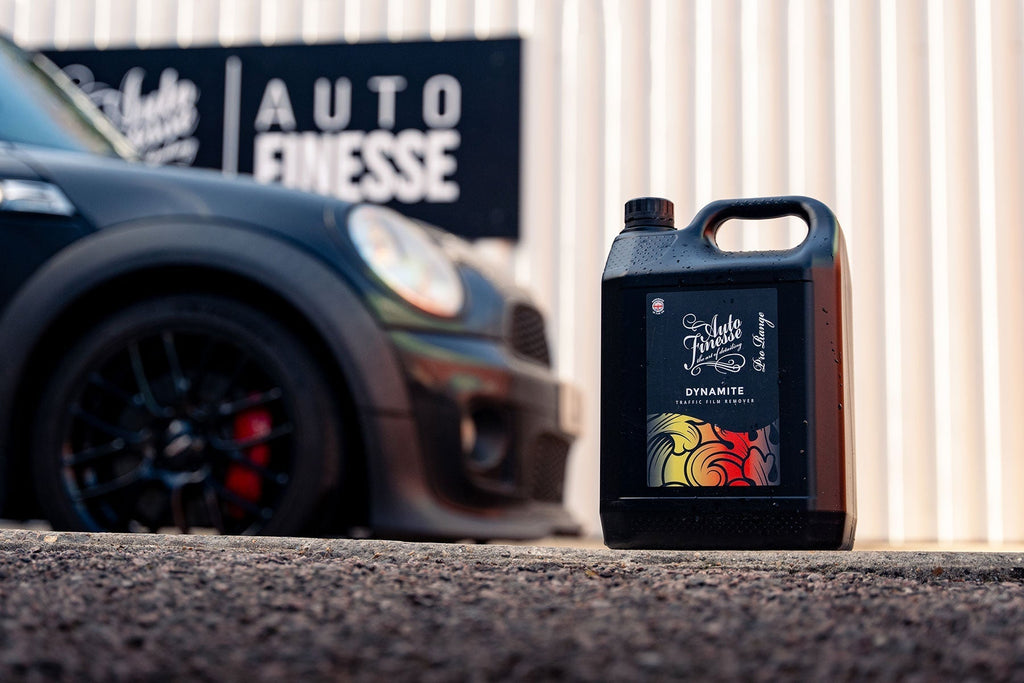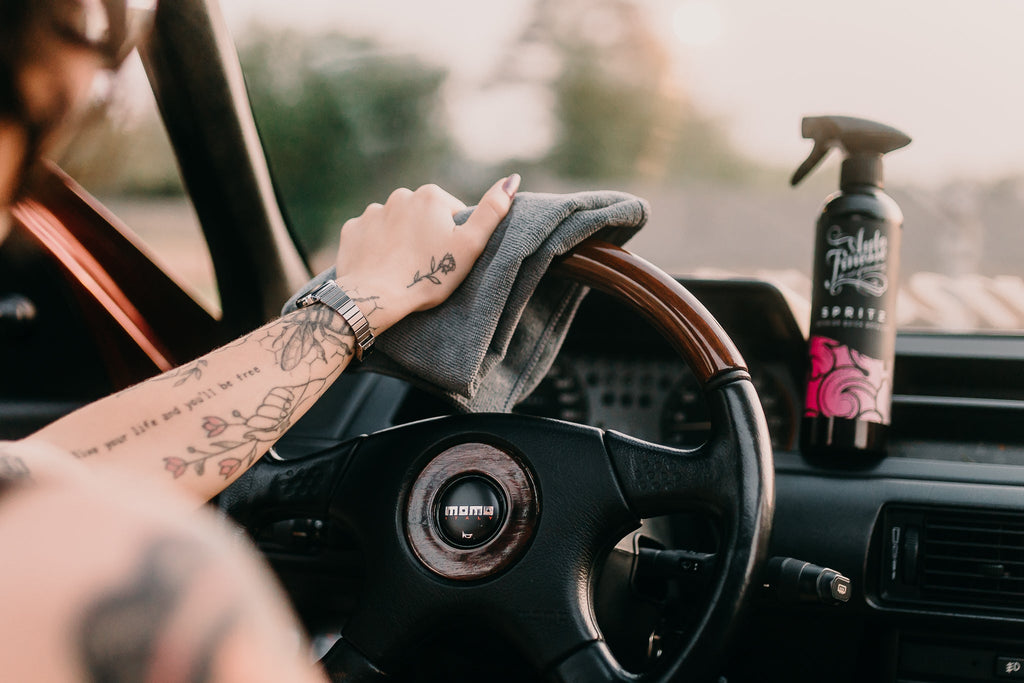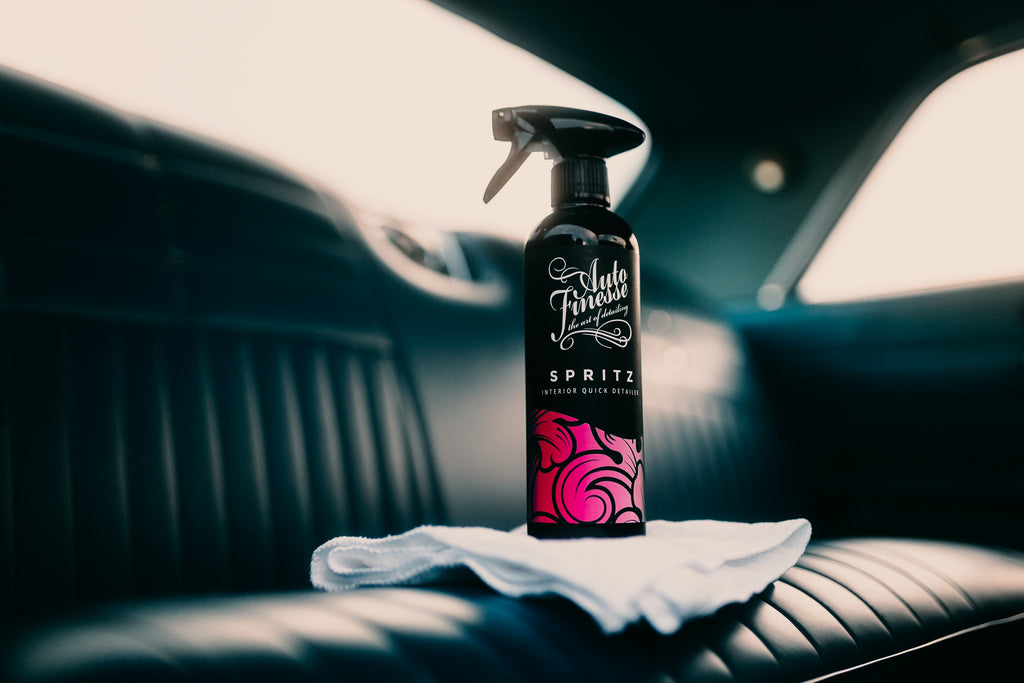Restoring & Protecting Gloss Plastic Trim

IN THIS FREE GUIDE:
- Learn how to and bring tired, swirly gloss plastic trim back to life, and stop it detracting from the rest of your detail.
- Discover the best detailing products you need to correct any level of swirling.
- Master every process in our simple, step-by-step guide and save money by doing the job yourself.
Don't let swirly plastic trims ruin your next detail
There's no doubt that those piano black pillar trims are the scourge of car enthusiasts the world over, even our Pro Detailers like to say; "don't even look at them, because they'll scratch!" So, it's an extremely common question as to how these are not only cleaned safely, but how they're fully restored when they're full of swirl marks. Not to mention the best detailing products to use along the way. After all, even on relatively new cars, these plastics can often appear to be a scratched, swirly mess, and that's not just because these areas are likely the most easily-damaged part of the whole vehicle (especially due to poor wash techniques), but because they also tend to see a huge amount of contact - whether that's from hedges on the road, people brushing past in the carpark, or simply as pillar trims seem to be everyone's first grab when closing a car door.
But, aside from leaving these trims as untouched as possible, and performing the safest maintenance routine possible, how can these be brought back to life? Well, here's what you can do to stop your plastic pillars from letting down your next detail…

How are gloss plastics different to other panels?
Although some manufacturers actually lacquer or gelcoat their plastic trims, which (arguably at least) makes polishing a little safer, for the majority of vehicles out there these piano black plastics are simply bare acrylic. Compared to paintwork and other lacquered surfaces, acrylic plastics have an extremely soft surface, the reason why careful cleaning and utilising a safe pre-wash before making any contact is essential in cutting down the risk of inflicting swirls. It goes without saying that prevention is always better than cure, right?
Unlike paintwork, which is technically a multi-layered substrate consisting of primer and a topcoat, (most often but not always) covered with a clear coat layer, and applied on top of a metal or plastic panel. Pillar trims are a single piece of plastic all the way through, there are no separate layers and no protection for the relatively soft surface.
This is important when it comes to using abrasives to cut and refine plastics because heat will quickly travel through and be stored in the whole piece. When it comes to performing any kind of correction, heat is always the chief concern because plastic doesn't dissipate the build-up of high temperatures like painted panels. In fact, plastic can be far more easily warped, and even burned level causing hazing on the surface. Heat will also soften the surface, making it sticky on a microscopic level and much harder to correct using abrasives.
On unlacquered plastics, the glossy finish also comes straight from light bouncing to the eye off of the very top of the surface, rather than from the observation of light traveling unrestricted through clearcoat and bouncing back off of the paintwork underneath. This means that swirl marks, acid etching and other defects are not only more easily inflicted, but they're more noticeable to the eye, the main reason why trims can look far worse than the rest of the car, even with comparable defects. We always use a Swirl Spotter Detailing Light to highlight defects when we polish any painted or gloss plastic surface of course, but outside in the sun these kind of swirls in plastic are particularly prevalent.

Should you hand or machine polish gloss plastic trim?
The simple answer is that either method can be used get the desired results, but while it is entirely possible to restore and refine gloss plastic trims by hand - for this we can recommend using our Revitalise Spot Pads attached to an ergonomic Handi Puck for the best results - just bear in mind that it will take a fair bit longer than with a machine polisher.
When it comes to machine polishing and working on smaller jobs like this it's important that your machine and pad combo isn't too big for panel you're polishing, in most cases this will require the use of a small 3-inch machine, like our MPX Dual Action Polisher.
As we said, heat is the enemy here but it can be combated by both the use of a Dual Action (DA) machine which will have an orbital rotation designed to limit the build-up of heat under the pad. And through carefully using shorter set times and lower speeds. Professional detailers will also move their machine across the panel at around twice the speed as on paintwork. You can learn more about different types of machine polishers, and how they work, in our Basic Guide to Machine Polishing.

What combo is best to use on gloss plastics?
While this will always depend on both the desired result and the level of defect you're trying to remove, it may be necessary to use a slightly less aggressive pad and compound than you would on painted surfaces.
The truth is that, unless you're correcting remarkably-light swirling, or plastics that have already been detailed (in which case Tripple All-in-One Polish is great for an enhancement), taking care of these is rarely a single stage process. In the vast majority of cases, and just like paintwork correction, a cutting stage will be needed for defect removal, followed by a refining stage to finish down and remove the hazing from the previous stage. For this we can use our Revitalise System V2 Compounds or our Pro Series Compounds.
For heavier swirl marks a three-stage correction (cutting with a coarser restoring compound first) may be needed for the initial correction, before more cutting and refining with progressively finer compounds. Even when that's the case though, it always pays to start off with a finer compound than you think you need, check the results, and then switch to a heaver cut only when necessary. Cutting plastics will always be easier than clearcoat, but refining down to flawless is always more difficult because of the softness of the surface, and the tendency to pick up more defects from the stage before.



Can gloss plastics be protected?
Ideally last stage protection should be used to safeguard your work, and if nothing else, to help make cleaning easier next time around. The key is to avoid putting defects back into your freshly polished trim. After all, even a dusty microfibre can scratch acrylic surfaces. With this in mind, we'd recommend using products that sit on the safe side of the fence when it comes to application.
Both our Ceramic Spray Wax and Glisten Spray Wax can be used effectively to add a layer of protection to gloss plastic trim, but always bear in mind that your choice may affect which polish or compound you use during the final refinement stage.
If you're simply enhancing the panel and removing the final light defects using Tripple All-in-One Polish for example, then a ceramic coating shouldn't be used over the top, simply because the carnauba wax in Tripple will block the surface bonding. The hardy winter protection that comes from ceramic protection requires the use of correction products that contain no wax, making our Revitalise System V2 or Pro Series Compounds the ideal cutting and refining products.
Glisten on the other hand, can be used over the top of our wax-free compounds and Tripple, and requires nothing more than a quick spray and a wipe.


Step By Step
To demonstrate, we tackled some gloss black pillar trims that had certainly seen better days, by performing a three-stage correction using our MPX Dual Action Polisher and our Revitalise System V2 Compounds and Revitalise Spot Pads.

Step 1: Inspection and Masking
As with any polishing stage, the surface has to be perfectly clean, dry and free from ingrained contaminants. Cleaning exterior plastic trim safely is exactly the same as cleaning paintwork - always pre-wash with Citrus Power Bug & Grime Remover and Avalanche Snow Foam before a safe two-bucket car wash with Lather Car Shampoo. But do bear in mind that any further decontamination processes should only be performed when absolutely necessary, the idea here is to avoid inflicting any more defects. Using a super soft Aqua Deluxe Towel to dry your trim is also essential, for exactly the same reason.
Masking off the plastic panels using Detailers Masking Tape is the next stage. This isn't just to protect the rubber around them, which can be easily stained with your compounds, but it also helps protect from inflicting yet more defects on your plastics. As you can imagine, hard rubber brushing against your pad will heat up, melt and stick, and transferring this to your gloss plastics on a fast-moving foam pad is a sure-fire way of inflicting even deeper scratches.

Step 2: Testing
The initial cutting stage is where the harshest defects are leveled down to their lowest point. Like all polishing processes, technically the defect itself isn't removed, but the whole surface around the defect is taken away until the bottom of the deepest defect is reached. This simply makes the swirls and scratches disappear.
From the start we can see the heavy swirling on this panel, and our expert detailer knows - simply from experience - that this will likely require all three stages of the Revitalise System, including a coarse, medium and fine cut process. But even so, we'll still begin the process by testing with the medium-cut Revitalise No:2 Polishing Compound and a medium Revitalise No:2 Spot Pad, just to check if there's enough cut to remove all of the swirling.
As always with any new pads, and especially on gloss plastics, it's also important to spritz on a little Pad Prime to prevent any initial scrubbing.
Just a few pea sized drops of compound are required for this job. First patting this around the panel to spread it out, before starting the machine (on the panel) at a moderate speed. Working relatively quickly across the panel helps to cut down on the heat generated by the pad, and in turn cuts down on the heat generated in any one spot.
After an initial pass we can up the speed for another pass, fully working through the compound, until the residue turns clear.
After wiping away the residue with a fresh Microfibre Work Cloth we could see that results were good and the majority of swirling was removed. But, we could also see that slightly more cut would be needed from a coarser compound to eradicate the deeper defects.
So, after our test, we have a plan. We'll use Revitalise No:1 Restoring Compound for the initial cutting, before working through the medium No:2 Polishing Compound and fine No:3 Restoring Compound (all with the respective Revitalise Spot Pads) to finish. The compound and pad colour coding helps to make everything nice and straightforward here.



Step 3: Cutting
Starting with our coarse Revitalise No:1 Restoring Compound and firm pad, using it in the same way, the heaver cut quickly removed the last of the heavier defects. This enables us to move back to the Revitalise No:2 Polishing Compound and a Revitalise No:2 Spot Pad, repeating the process, to remove the heavier hazing from the initial coarse cut.
You can learn more about how different types of pads work in our article: Machine Polishing Pads: Everything You Need To Know.





Step 4: Refining
After finishing the second round of cutting, the refining stage is where we finish down to remove the last of the marks that are visible to the eye. Once again, this stage is performed in exactly the same way, but using our fine Revitalise No:3 Refining Compound and a soft foam Revitalise No:3 Spot Pad.
Technically of course refining is still cutting, it's just a term we use for the final stage of using fine abrasives to achieve an extremely fine cut. The idea is to remove any hazing from the previous stage, bringing back the glossy finish to the plastic.




Step 5: Protection
And, after completing the processes on both sides of the trim, and on both sides of the car, that's them fully restored so, after removing the masking tape, the final step is always adding a little protection.
As we said either Ceramic Spray Wax or Glisten Spray Wax are effective for quick and easy protection here, and both can be used in conjunction with our Revitalise Compounds, because these abrasive products contain no waxes or fillers. In this case we opted for a quick spritz of Glisten for up to a month of protection and whole load of added gloss, we'll top this up after every maintenance wash.












Glisten is a high-tech spray car wax specifically developed for a speedy finish with 4-weeks of protection and acres of gloss… and all with nothing more than a... See product details More
Ands that's how you can restore and protect your plastic trims like a pro. Why not have a go during your next detail and see how this simple process can push your results to the next level?
Be sure to check out more top how-tos in the Guides Section Of Our Blog.

















































